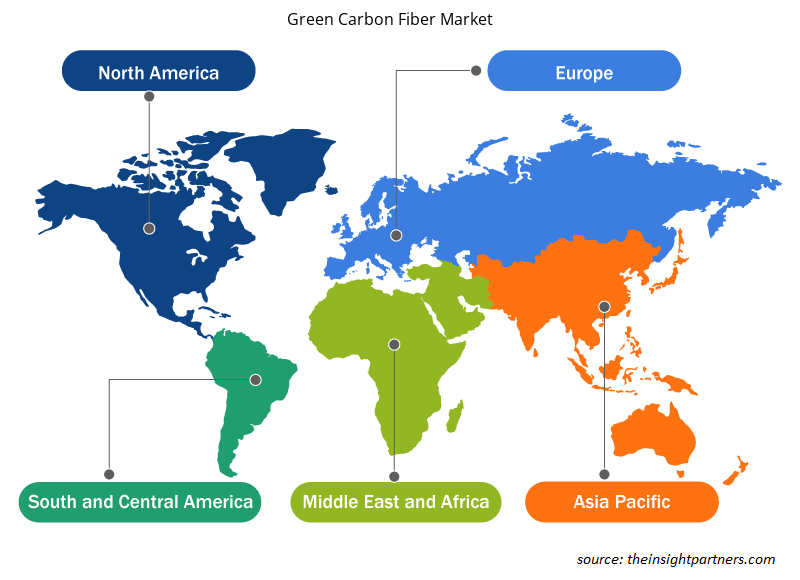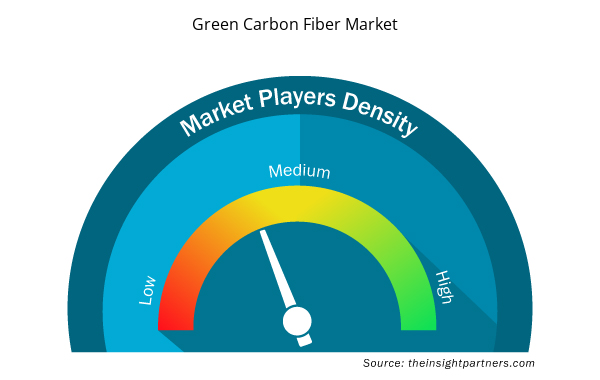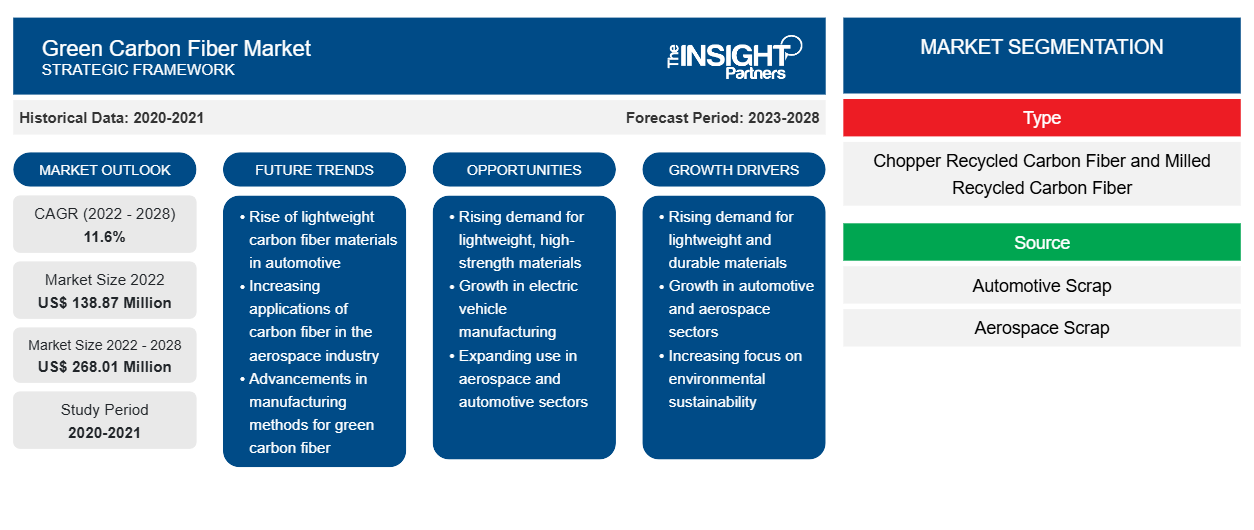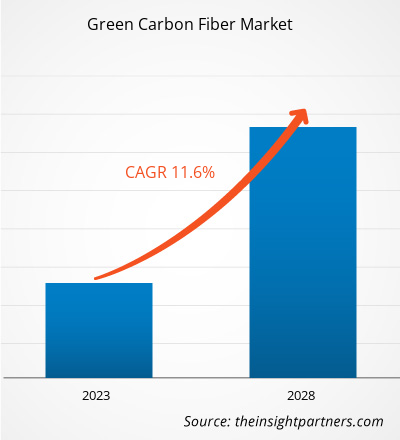[研究报告] 2022年绿色碳纤维市场价值为 1.3887 亿美元,预计到 2028 年将达到 2.6801 亿美元;预计 2022 年至 2028 年的复合年增长率为 11.6%。
绿色碳纤维是一种再生碳纤维。碳纤维回收是从碳纤维增强复合材料 (CFRC) 中回收纤维。碳纤维废料有两种类型。第一种废料是原生碳纤维——由干纤维和未使用的过期材料产生的产品边角料,也称为废料。绿色或再生碳纤维用于制造各种终端使用领域的新型高性能部件。绿色碳纤维的优势,以及汽车、航空航天、风能、体育用品等各种终端使用行业对经济高效、轻质材料的需求不断增加,正在推动绿色碳纤维市场的增长。
2022 年,亚太地区占据全球绿色碳纤维市场的最大份额,预计欧洲在预测期内的复合年增长率最高。亚太绿色碳纤维市场分为中国、日本、印度、韩国、澳大利亚和亚太其他地区。过去几年,亚太地区的航空航天和国防工业一直在显着增长。在亚太地区,中国是最大的飞机制造商之一,也是国内航空旅客最大的市场之一。
定制此报告以满足您的需求
您可以免费定制任何报告,包括本报告的部分内容、国家级分析、Excel 数据包,以及为初创企业和大学提供优惠和折扣
- 获取此报告的关键市场趋势。这个免费样品将包括数据分析,从市场趋势到估计和预测。
COVID-19 疫情对绿色碳纤维市场的影响
在 COVID-19 疫情期间,中国、印度和日本等亚太国家因制造工厂关闭、供应链中断和原材料短缺而面临重大挑战;这导致产品制造和分销大幅下滑。尽管如此,这场疫情也为亚太地区绿色碳纤维市场的主要参与者带来了一些有利可图的机会。绿色碳纤维市场的许多公司在第二波 COVID-19 期间或之后开始实施政府协议和规范来销售其产品,以抓住这一机会并增加销量。因此,政府的支持往往会增加对可持续碳纤维的需求,从而推动绿色碳纤维市场的增长。
市场洞察
风能行业绿色碳纤维使用量的增加推动了绿色碳纤维市场
随着世界各国从破坏气候的不可再生化石燃料转向清洁的可再生能源,对风力涡轮机的需求正在迅速增长。此外,不断上涨的电价也推动了对可再生能源的需求。随着美国、德国、沙特阿拉伯和中国等各国政府采取措施生产可再生能源,风能市场正在增长。对可再生能源(尤其是风能)的需求增加,以及减少对化石燃料发电依赖的努力是风能领域增长的重要因素,最终推动了绿色碳纤维市场的增长。
用原生碳纤维 (VCF) 增强的聚合物用于制造风力涡轮机叶片的翼梁帽,而用玻璃纤维增强的聚合物用于制造叶片部件的外皮。然而,绿色碳纤维现在被广泛用于风力涡轮机,因为再生碳纤维混合叶片的环境性能提高了 12-89%。再生碳纤维混合叶片的能源和碳回收时间比市场现有产品低 5-13%。使用再生碳纤维制造风力涡轮机叶片部件在机械上是可行的,并且比玻璃纤维具有显着的环境效益。碳纤维的这些特性有助于生产更好的风力涡轮机和更高的能量产量。因此,风能行业对绿色碳纤维的使用越来越多,推动了市场的增长。
基于类型的洞察
根据类型,绿色碳纤维市场分为短切再生碳纤维和研磨再生碳纤维。研磨再生碳纤维部分在 2022 年占据了更大的市场份额。研磨再生碳纤维是通过将短切纤维研磨成粉末(研磨)形式制成的。研磨再生碳纤维的通常长度为 80-100 微米。这些纤维具有静电耗散和强度。
基于来源的洞察
根据来源,绿色碳纤维市场分为汽车废料、航空废料和其他。汽车废料部分预计在预测期内的复合年增长率最高。制造汽车碳纤维增强塑料 (CFRP) 产生的约 40-60% 废料可获得再生碳纤维。使用再生碳纤维可以帮助汽车制造商提高车辆的行驶里程。
基于应用的洞察
根据应用,绿色碳纤维市场细分为航空航天、汽车、风能、体育用品等。汽车领域在 2022 年占据了最大的市场份额。汽车行业经常使用再生碳纤维来制造底盘面板、地板、车顶面板、备胎舱以及行李箱或发动机罩内衬。
该公司采用闭环工艺回收干碳纤维。使用回收碳纤维生产汽车的成本相对低于钢铁生产成本。此外,回收碳纤维可以成型并塑造成不同的形状,而钢铁则不能。回收碳纤维的这些特性正在增强其在汽车领域的需求。
绿色碳纤维市场的主要参与者包括 Procotex Corp SA、Vartega Inc、Sigmatex (UK) Ltd、Shocker Composites LLC、Carbon Conversions Co、SGL Carbon SE、Toray Industries Inc、Gen 2 Carbon Ltd、Catack-H Co Ltd 和 Innovative Recycling。这些公司专注于新产品的发布和地域扩张,以满足全球日益增长的消费者需求。它们在全球拥有广泛的业务,这使它们能够服务于大量客户,从而增加其市场份额。这些市场参与者高度重视新产品的发布和区域扩张,以增加其专业产品组合中的产品范围。
绿色碳纤维市场区域洞察
Insight Partners 的分析师已详尽解释了预测期内影响绿色碳纤维市场的区域趋势和因素。本节还讨论了北美、欧洲、亚太地区、中东和非洲以及南美和中美洲的绿色碳纤维市场细分和地理位置。

- 获取绿色碳纤维市场的区域具体数据
绿色碳纤维市场报告范围
| 报告属性 | 细节 |
|---|---|
| 2022 年市场规模 | 1.3887亿美元 |
| 2028 年市场规模 | 2.6801亿美元 |
| 全球复合年增长率(2022 - 2028) | 11.6% |
| 史料 | 2020-2021 |
| 预测期 | 2023-2028 |
| 涵盖的领域 | 按类型
|
| 覆盖地区和国家 | 北美
|
| 市场领导者和主要公司简介 |
|
绿色碳纤维市场参与者密度:了解其对业务动态的影响
绿色碳纤维市场正在快速增长,这得益于终端用户需求的不断增长,而这些需求又源于消费者偏好的不断变化、技术进步以及对产品优势的认识不断提高等因素。随着需求的增加,企业正在扩大其产品范围,进行创新以满足消费者的需求,并利用新兴趋势,从而进一步推动市场增长。
市场参与者密度是指在特定市场或行业内运营的企业或公司的分布情况。它表明在给定市场空间中,相对于其规模或总市场价值,有多少竞争对手(市场参与者)存在。
在绿色碳纤维市场运营的主要公司有:
- 南非普罗科泰克斯公司
- 瓦特加公司
- Sigmatex(英国)有限公司
- Shocker 复合材料有限责任公司
- 碳转化公司
免责声明:上面列出的公司没有按照任何特定顺序排列。

- 了解绿色碳纤维市场顶级关键参与者概况
报告亮点
- 绿色碳纤维市场的渐进式行业趋势,帮助企业制定有效的长期战略
- 发达国家和发展中国家市场参与者采用的业务增长战略
- 2022 年至 2028 年市场定量分析
- 全球绿色碳纤维需求量预估
- 波特五力分析说明绿色碳纤维市场中买家和供应商的效力
- 了解竞争市场状况的最新发展
- 绿色碳纤维市场趋势和展望、增长动力和限制因素
- 通过强调支撑商业利益的市场策略来协助决策过程
- 不同节点的绿色碳纤维市场规模
- 绿色碳纤维行业详细概述和动态
- 各地区绿色碳纤维市场规模及增长潜力巨大
- 历史分析(2 年)、基准年、预测(7 年)及复合年增长率
- PEST 和 SWOT 分析
- 市场规模价值/数量 - 全球、区域、国家
- 行业和竞争格局
- Excel 数据集



Report Coverage
Revenue forecast, Company Analysis, Industry landscape, Growth factors, and Trends

Segment Covered
This text is related
to segments covered.

Regional Scope
North America, Europe, Asia Pacific, Middle East & Africa, South & Central America

Country Scope
This text is related
to country scope.
常见问题
The major players operating in the global green carbon fibers market are Procotex Corp SA, Vartega Inc, Sigmatex (UK) Ltd, Shocker Composites LLC, Carbon Conversions Co, SGL Carbon SE, Toray Industries Inc, Gen 2 Carbon Ltd, Catack-H Co Ltd, and Innovative Recycling.
Key strategic developments by green carbon fiber manufacturers to provide potential market opportunities in the coming years for the green carbon fiber. The green carbon fiber market is growing with an upward trend. Market players focus on strategic activities such as collaborations and acquisitions are surging the market growth of green carbon fibers. For instance, In 2021, Procotex Corporation acquired ELG Carbon Fiber. The acquisition aims to enable the company to produce improved carbon fiber and feedstock capacities. In December 2019, The Institute for Railway Research at the University of Huddersfield and ELG Carbon Fiber Ltd. (U.K.) collaborated to produce the world's first CAFIBO (carbon fiber bogie).
Based on type, milled recycled carbon fiber segments mainly have the largest revenue share. Milled recycled carbon fiber is made by grinding chopped fiber into a powder (milled) form. The usual length of milled recycled carbon fiber is 80–100 micrometers. These fibers offer electrostatic dissipation and strength. It has short strands of recycled carbon fiber and is commonly available in powdered form. Milled recycled carbon fiber offers mechanical properties such as modulus and tensile. The fiber also offers electrical conductivity and dimensional stability. This type of fiber is compatible with thermoplastic and thermoset resin systems. It has applications in various end-use industries, including construction & infrastructure and automotive & transportation.
Asia Pacific accounted for the largest share of the global green carbon fibers market. In Asia Pacific, the demand for green carbon fiber is increasing due to a rise in the manufacturing of lightweight CFRP products for electric cars, airplanes, windmills, etc. When not recycled, these materials negatively impact the environment owing to either hazardous gases emitted during incineration or the landfilling of these nonbiodegradable products. Considering these issues, recycling of carbon fibers has gained importance. Thus, manufacturers across the region are increasingly developing technologies to recycle carbon fiber as the demand for green fiber is increasing among end-use industries.
Benefits of green carbon fiber is driving the green carbon fibers market. Green carbon fiber provides environmental sustainability, cost-effectiveness, energy efficiency, and lightweight benefits. Thus, green carbon fibers are tremendously used in battery boxes, lift gate systems, pressure vessels, wind turbines, aircraft, sporting goods, etc. The increased demand for lightweight materials in defense, automotive, sporting goods, and aerospace industries drives the green carbon fiber market. In addition, owing to rising pollution control regulations in developing countries such as China and India, the demand for lightweight car materials is rising which assist in reduced car emission. This factor is surging the demand for green carbon fibers in the automotive industry as it is a lightweight material.
Based on the application, wind energy segment is projected to grow at the fastest CAGR over the forecast period. The installations of wind turbines are growing due to the rising demand for utilizing renewable resources. Wind turbine manufacturers are now targeting to produce longer, efficient blades. Polymers reinforced with virgin carbon fibers (VCF) are being used to make spar caps of wind turbine (WT) blades, and polymers with glass fibers (GF) are used to make skins of the blade components. Using recycled carbon fibers for wind turbine blade parts can be mechanically feasible and offer significant environmental benefits over glass fibers. These properties of carbon fiber have helped produce better wind blade turbines resulting in higher wind energy production.
Trends and growth analysis reports related to Chemicals and Materials : READ MORE..
The List of Companies - Green Carbon Fiber Market
- Procotex Corp SA
- Vartega Inc
- Sigmatex (UK) Ltd
- Shocker Composites LLC
- Carbon Conversions Co
- SGL Carbon SE
- Toray Industries Inc
- Gen 2 Carbon Ltd
- Catack-H Co Ltd
- Innovative Recycling
The Insight Partners performs research in 4 major stages: Data Collection & Secondary Research, Primary Research, Data Analysis and Data Triangulation & Final Review.
- Data Collection and Secondary Research:
As a market research and consulting firm operating from a decade, we have published and advised several client across the globe. First step for any study will start with an assessment of currently available data and insights from existing reports. Further, historical and current market information is collected from Investor Presentations, Annual Reports, SEC Filings, etc., and other information related to company’s performance and market positioning are gathered from Paid Databases (Factiva, Hoovers, and Reuters) and various other publications available in public domain.
Several associations trade associates, technical forums, institutes, societies and organization are accessed to gain technical as well as market related insights through their publications such as research papers, blogs and press releases related to the studies are referred to get cues about the market. Further, white papers, journals, magazines, and other news articles published in last 3 years are scrutinized and analyzed to understand the current market trends.
- Primary Research:
The primarily interview analysis comprise of data obtained from industry participants interview and answers to survey questions gathered by in-house primary team.
For primary research, interviews are conducted with industry experts/CEOs/Marketing Managers/VPs/Subject Matter Experts from both demand and supply side to get a 360-degree view of the market. The primary team conducts several interviews based on the complexity of the markets to understand the various market trends and dynamics which makes research more credible and precise.
A typical research interview fulfils the following functions:
- Provides first-hand information on the market size, market trends, growth trends, competitive landscape, and outlook
- Validates and strengthens in-house secondary research findings
- Develops the analysis team’s expertise and market understanding
Primary research involves email interactions and telephone interviews for each market, category, segment, and sub-segment across geographies. The participants who typically take part in such a process include, but are not limited to:
- Industry participants: VPs, business development managers, market intelligence managers and national sales managers
- Outside experts: Valuation experts, research analysts and key opinion leaders specializing in the electronics and semiconductor industry.
Below is the breakup of our primary respondents by company, designation, and region:

Once we receive the confirmation from primary research sources or primary respondents, we finalize the base year market estimation and forecast the data as per the macroeconomic and microeconomic factors assessed during data collection.
- Data Analysis:
Once data is validated through both secondary as well as primary respondents, we finalize the market estimations by hypothesis formulation and factor analysis at regional and country level.
- Macro-Economic Factor Analysis:
We analyse macroeconomic indicators such the gross domestic product (GDP), increase in the demand for goods and services across industries, technological advancement, regional economic growth, governmental policies, the influence of COVID-19, PEST analysis, and other aspects. This analysis aids in setting benchmarks for various nations/regions and approximating market splits. Additionally, the general trend of the aforementioned components aid in determining the market's development possibilities.
- Country Level Data:
Various factors that are especially aligned to the country are taken into account to determine the market size for a certain area and country, including the presence of vendors, such as headquarters and offices, the country's GDP, demand patterns, and industry growth. To comprehend the market dynamics for the nation, a number of growth variables, inhibitors, application areas, and current market trends are researched. The aforementioned elements aid in determining the country's overall market's growth potential.
- Company Profile:
The “Table of Contents” is formulated by listing and analyzing more than 25 - 30 companies operating in the market ecosystem across geographies. However, we profile only 10 companies as a standard practice in our syndicate reports. These 10 companies comprise leading, emerging, and regional players. Nonetheless, our analysis is not restricted to the 10 listed companies, we also analyze other companies present in the market to develop a holistic view and understand the prevailing trends. The “Company Profiles” section in the report covers key facts, business description, products & services, financial information, SWOT analysis, and key developments. The financial information presented is extracted from the annual reports and official documents of the publicly listed companies. Upon collecting the information for the sections of respective companies, we verify them via various primary sources and then compile the data in respective company profiles. The company level information helps us in deriving the base number as well as in forecasting the market size.
- Developing Base Number:
Aggregation of sales statistics (2020-2022) and macro-economic factor, and other secondary and primary research insights are utilized to arrive at base number and related market shares for 2022. The data gaps are identified in this step and relevant market data is analyzed, collected from paid primary interviews or databases. On finalizing the base year market size, forecasts are developed on the basis of macro-economic, industry and market growth factors and company level analysis.
- Data Triangulation and Final Review:
The market findings and base year market size calculations are validated from supply as well as demand side. Demand side validations are based on macro-economic factor analysis and benchmarks for respective regions and countries. In case of supply side validations, revenues of major companies are estimated (in case not available) based on industry benchmark, approximate number of employees, product portfolio, and primary interviews revenues are gathered. Further revenue from target product/service segment is assessed to avoid overshooting of market statistics. In case of heavy deviations between supply and demand side values, all thes steps are repeated to achieve synchronization.
We follow an iterative model, wherein we share our research findings with Subject Matter Experts (SME’s) and Key Opinion Leaders (KOLs) until consensus view of the market is not formulated – this model negates any drastic deviation in the opinions of experts. Only validated and universally acceptable research findings are quoted in our reports.
We have important check points that we use to validate our research findings – which we call – data triangulation, where we validate the information, we generate from secondary sources with primary interviews and then we re-validate with our internal data bases and Subject matter experts. This comprehensive model enables us to deliver high quality, reliable data in shortest possible time.


 获取此报告的免费样本
获取此报告的免费样本